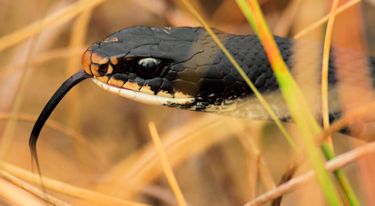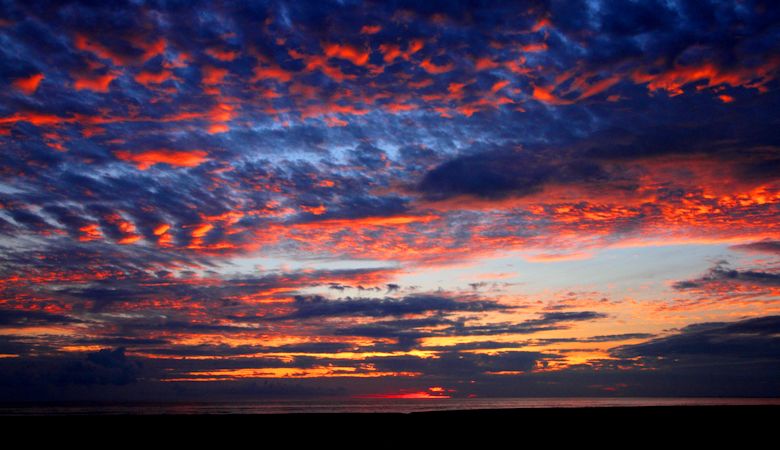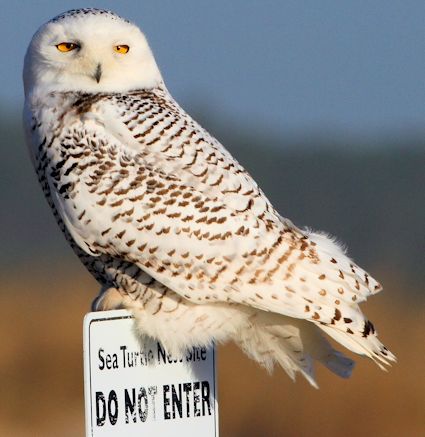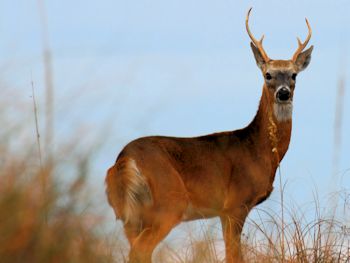
The snowy owl, a bird of the high Arctic tundra, loves the wide open spaces, like the beaches of Cape Hatteras.
Supporter Spotlight
Snowy Owl(Bubo scandiacus) From the Cornell Lab of Ornithology Size & Shape: Snowy owls are very large owls with smoothly rounded heads and no ear tufts. The body is bulky, with dense feathering on the legs that makes the bird look wide at the base when sitting on the ground. Color: White with varying amounts of black or brown markings on the body and wings. On females this can be quite dense, giving the bird a salt-and-pepper look. Males tend to be paler and become whiter as they age. The eyes are yellow. Habitat: In winter, look for the owls along shorelines of lakes and the ocean, as well as on agricultural fields and airport lands. Snowy owls breed in the treeless arctic tundra. Supporter SpotlightDiet: Small mammals, particularly lemmings, which at times on the tundra may be all these birds eat. Sometimes they’ll switch to ptarmigan and waterfowl. The snowy is also one of the most agile owls, able to catch small birds on the fly. On both their breeding and wintering grounds, their diet can range widely to include rodents, rabbits, hares, squirrels, weasels, wading birds, seabirds, ducks, grebes and geese. Migration: Migrations are extremely variable. Some winter in southeastern Canada, the upper Great Lakes states and New England just about every year. Winter numbers in the U.S. peak periodically, which may be attributed to lemming cycles farther north. During irruptive years, snowy owls can flush south throughout the lower 48 states, as far as south as Texas and Florida in extreme years. |
BUXTON — It started snowing on Cape Hatteras National Seashore on Nov. 26 and as far as I know, it hasn’t stopped.
That was the day that park rangers first discovered that a snowy owl was taking up temporary residence near Cape Point. It is a big deal for this species of bird to show up in North Carolina, and it has even the most-seasoned, spotting scope-carrying, binocular-laden bird watchers scrambling to get ferry reservations to the Cape to add this nomad to their life list.
Photos By Sam Bland |
This is a bird of the high Arctic tundra that’s also called the Arctic owl, the Great White Owl and, my favorite, the White Terror of the North. It loves wide open spaces, and the windswept beaches and the dunes along the N.C. coast are a good substitute.
I first learned about the sighting on Nov. 27 through a friend of a friend on a Facebook post. Nice, I thought, but I wasn’t considering heading out to Cape Hatteras to look for this bird. In my past, I have set off in hot pursuit after unusual animal sightings that resulted in nothing more than wild goose chases. Unreliable information, such as the badger that turned out to be a fox squirrel, has also discouraged me from bolting out the door to see the unexpected. However, after my friend posted some striking photos of this stunning bird following his excursion to the beach, I packed a bag and headed to the Outer Banks.
I left early in the morning to catch the 7 a.m. Cedar Island ferry to Ocracoke, and my excitement was quickly dampened by a thick curtain of cotton candy fog. I made it to the dock in plenty of time, but I knew that even in an era when boats are equipped with radar, GPS and blasting fog horns that the ferry would not depart until the fog lifted. After a delay of about an hour, to my surprise, the boat slowly cruised into a misty veil of uncertainty. I stood at the stern of the ferry looking back at the dock as it quickly melted into a cloak of clouds and I felt a little gloomy about my chances of seeing the snowy. Just then, I saw an Atlantic bottlenose dolphin surface directly behind the boat. A good sign, I thought, and my mood was immediately brightened.
The fog had greatly dissipated two hours later at Ocracoke, with only a few wispy patches here and there. I zipped north up the island, caught the Hatteras Island ferry and soon found myself at a parking area near the beach at the Cape Hatteras National Seashore. I prepared my camera gear, slipped on a day pack and headed out to the beach. Even though I was focused on finding the snowy, I was soon distracted by views of the Cape Hatteras lighthouse through the dunes on what had transformed into a beautiful day with unseasonably warm temperatures.
The hike took me past what is known as the Salt Pond and I was distracted even more by taking time to check out the tundra swans and an assortment of waterfowl swimming on the surface. Nearby, a northern harrier flew low over the vegetation that ringed the pond as it scouted for prey.
Eventually, I made my way to a section of the beach where sightings of the bird had been reported. I began hiking parallel to the shoreline just behind the small lumpy dunes that would provide the cover needed to prevent spooking the bird if I found it.
How hard could it be to find this bird? It is large, standing about two feet tall, and is almost all white and should be in sharp contrast with the light brown colored sand.
 A harmless black racer darts through the grass and rattles its tail as an empty warning. A harmless black racer darts through the grass and rattles its tail as an empty warning. |
About every hundred yards, I poked my head above the dunes and scanned the beach with my binoculars. I hiked about two miles down the beach without seeing another soul or a snowy owl for that matter. As I retraced my steps back to my truck with my head hung low in defeat, I noticed the remains of a coot, a marsh rabbit and a shorebird scattered at different locations. This was a good sign that the snowy was still around and at work or it could have been the results of a peregrine falcon.
With a couple of hours of sunlight left, I drove to another beach access and began hiking a trail back to the beach. The trail split and I purposefully took the more intriguing option due to get a better look at what looked like a long, black stick stretched across the sandy path. As I got closer, the stick began to move slowly towards the dune. I raced after the object just in time to see a long black racer glide safely into the grasses. It paused to flick its tongue and rattle its tail among the dry grass blades in an effort to imitate a threatening rattlesnake before vanishing over the dune.
Heading back to the main trail, I heard the familiar stomp and snort of an irritated white-tailed deer. Up on a dune, I saw a small buck, unhappy with my presence, being protective of a nearby doe.
Back out on the beach, I hunkered down with a good view of the open beach and waited on the snowy owl. As the fading sun cast the sand in a golden glow, I once again patrolled the dune line in search of the elusive snowy. Down on the open beach, about a half mile away, I saw a group of four people doing the same. I walked over to inquire about the snowy and was surprised to see a former co-worker. The group was out celebrating a birthday with hopes of seeing the snowy, but without luck.
With the sun dousing itself into the ocean, the sky turned red. The group headed in one direction towards their vehicle and I went the opposite way to my truck. I had just reached it when a vehicle pulled beside me. Inside were the other birders. They had seen the snowy as they were leaving the beach. What a fine birthday gift, I thought. Even though I didn’t see the bird, I was excited by the prospects of seeing the owl the next day.

The sun sinks into the Atlantic in a dazzling displays that promises better prospects for the next day.
The next morning, I rose early to get in a little exercise before heading to the beach. It was still dark out as I jogged north on N.C. 12. As I ran past the last street light in north Buxton, I was soon in complete darkness with the stars as my companions along with a few phosphorescent insects glowing in the grass beside the road.
I was back out on the beach before the rising sun and even before the steady stream of fishermen in their trucks heading to the Point. Moving quickly, I wanted to be the first one on the beach to avoid activity that might flush the snowy. The rising sun created dramatic backlighting on the clouds that towered above the horizon, giving the illusion of a mountainous landscape. I followed my same sad lonely meandering footprints of the day before and tried to remain hopeful.
After skirting behind the dunes for about 100 yards, I peeked out onto the open beach and there it was standing on a small mound of sand about 70 yards away. I watched the owl through binoculars. It seemed oblivious to my presence. It scanned to the left and to the right and into the sky above. It then swiveled its head and stared directly at me, its brilliant clear yellow eyes penetrating into my soul. This bird now had an admirer.
 It’s easy to see why this magnificent snowy owl has attracted a crowd of excited seekers. It’s easy to see why this magnificent snowy owl has attracted a crowd of excited seekers. |
And it’s not just me; snowy owls have been the subject of folklore and mythology for centuries and have even been depicted in prehistoric cave paintings in Europe.
I retreated behind a dune and prepared my camera to attempt a few photographs. The sun had now cleared the clouds and a warm glow covered the bird. After taking a few photos, I watched the snowy for about 30y minutes.
Due to the black barring on the white plumage, it appeared that this snowy was a female.
It then leaped into the air using powerful strokes of its wings and flew low over the beach for half mile before alighting atop a 10-foot dead tree branch that had most likely been stuck in the sand by a bird watcher.
Unlike other owls, the snowy will hunt during the day. Since their eyes are fixed in the socket, they can rotate their head 270 degrees scanning for prey using their extraordinary eyesight.
Startled by a National Park Service truck coming slowly down the beach, the bird flew and out of sight. The truck drove about a mile down the beach and stopped.
I hiked down the open beach to talk with the rangers. When I arrived at their truck, the rangers had a spotting scope focused in on the snowy at its new perch, a “Sea Turtle Nest Site” sign. We chatted about how unusual it is for this Arctic bird to be so far south.
This fall, numerous snowy owls have been showing up in unusual southern locations. Such migrations, which happen every few years, are known as an irruption. These movements are usually triggered by severe cold and snow, an abundance of snowy owls or a decline in their main Arctic prey, lemmings. In 2011, a large irruption resulted in snowy owls being reported in 35 states.
One of the hot spots this year is Logan Airport in Boston, Mass. where over 15 of the owls are attracted to the tundra-like landscape surrounding the airport. With winter just arriving it’s likely that reports of snowy owls will only increase. This is the first appearance of a snowy in North Carolina in 13 years. They’ve already been seen in nine counties, including Dare, Hyde, Wake, Beaufort, New Hanover, Randolph, Rockingham and Transylvania. In Carteret County, one was sighted out on Shackelford Banks on Dec. 15. It is thought that these sightings represent 10 or 11 different birds.
The rangers left to continue their duties and I was left alone on the open beach near the owl. I took a few more photos. When I began hiking back to the cover of the dunes, the bird spooked and flew farther down the beach.
 The buck, protecting a nearby doe, gave Sam a wary look and a menacing snort. The buck, protecting a nearby doe, gave Sam a wary look and a menacing snort. |
I hiked in the direction of the bird and saw a small group of birders who were setting up scopes near one of the beach access roads. I briefly spoke with them and discovered that one birder had driven nine hours with two small children to see the bird.
Again, I hiked behind the dunes to get one last look of the bird before departing. Here the dunes were smaller and I had to lay prone on the sand and combat crawl to keep my profile low. Still lying prone, I used my day pack as a tripod and set up my long lens to view the bird as it sat among a few tufts of beach grass that offered a bit of camouflage. I took a few pictures but mainly viewed the bird as it preened its feathers that also cover the legs and claws. Their thick white feathers contain no pigment which allows for more insulating air space to trap warmth and prevent heat loss. Due to their voluminous feathers, at close to six pounds, it is the heaviest owl in North America.
I crawled back behind the dunes and hiked back to my truck. I had spent a good part of the morning with this elegant bird and felt fortunate to do so. The truck must have been on auto-pilot as I don’t really remember driving to the Hatteras ferry dock as I relived the encounter. The ferry attendant made sure I got on the ferry as it was obvious that I was driving under the influence of owls, hypnotized, mesmerized and intoxicated by this snowy beauty.
Seeing this snowy owl was truly a precious gift from nature, a gift of a white Christmas.







